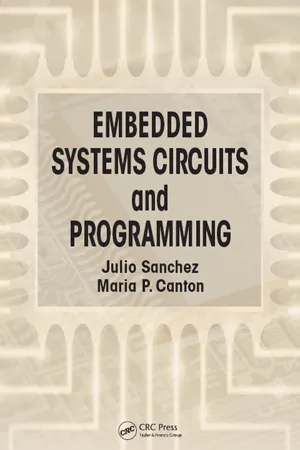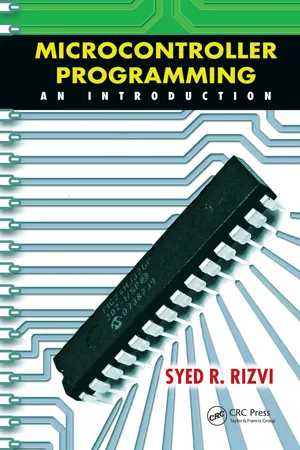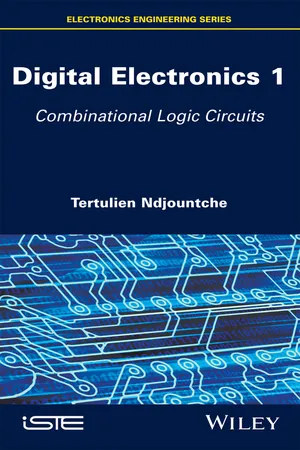Physics
Logic Switch
A logic switch is a fundamental component in digital electronics that can be in one of two states: on or off, representing binary values of 1 and 0. It is used to control the flow of electrical signals in electronic circuits, enabling the processing and manipulation of digital information. Logic switches are essential for the operation of computers, calculators, and other digital devices.
Written by Perlego with AI-assistance
Related key terms
5 Key excerpts on "Logic Switch"
- eBook - ePub
Electronics
from Classical to Quantum
- Michael Olorunfunmi Kolawole(Author)
- 2020(Publication Date)
- CRC Press(Publisher)
2 Functional LogicsMany tasks in modern computer, communications, and control systems are performed by logic circuits. Logic circuits are made of gates . A logic gate is a physical device that implements a Boolean function that performs a logic operation on one or more logical inputs (or terminals) and produces a single logical output. This chapter examines the basic principles of logic gates: the types—from primitive to composite gates—and how they are arranged to perform basic and complex functions.2.1 The Logic of a Switch
Basic logic circuits with one or more inputs and one output are known as gates . Logic gates (or simply gates ) are used as the building blocks in the design of more complex digital logic circuits. A logic gate is a physical device that implements a Boolean function that performs a logic operation on one or more logical inputs (or terminals) and produces a single logical output. Practically, gates function by “opening” or “closing” to allow or reject the flow of digital information. For any given moment, every terminal is in one of the two binary conditions “0” (low) or “1” (high). These binary conditions represent different voltage levels; that is, any voltage v up to the device threshold voltage, V th , (i.e. 0 ≤ v ≤ V th ); and in the conduction ranges 0 ≤ v ≤ 2.5 V and 2.5 < v ≤ 5 V represent logic states “0” and “1,” respectively.Note that machine arithmetic is accomplished in a two-value (binary) number system, but Boolean algebra—a two-value symbolic logic system—is not a generalization of the binary number system. The symbols 0, 1, +, and • are used in both systems but with totally different meanings in each system. (The meanings of these symbols become obvious during discussions in the next paragraphs.) This symbolic tool allows us to design complex logic systems with the certainty that they will carry out their function exactly as intended. Conversely, Boolean algebra can be used to determine exactly what function an existing logic circuit was intended to perform. So, writing Boolean functional expressions allows us to observe the expected output logic of the simple or complex gates’ design or construction. - eBook - ePub
- Julio Sanchez, Maria P. Canton(Authors)
- 2017(Publication Date)
- CRC Press(Publisher)
Chapter 3 Logic Gates and Circuit Components 3.1 Logic GatesA logic gate can be a virtual or a physical device. In either case the logic gate takes one or more binary signals as input and produces a binary output as a logical function. The basic logical operations of AND, OR, XOR, and NOT are described in basic electronics and Boolean algebra texts. Although logic gates can be made from electromagnetic relays, mechanical switches, or optical components, nowadays they are normally implemented using diodes and transistors.Charles Babbage’s Analytical Engine, devised around 1837, used mechanical logic gates based on gears. Electromagnetic relays were later used for logic gates, and these were eventually replaced by vacuum tubes, as Lee De Forest’s modification of the Fleming valve can be used as an AND logic gate. In 1937, Claude E. Shannon wrote a thesis paper that introduced the use of Boolean algebra in the analysis and design of switching circuits. The first modern electronic gate was invented by Walther Bothe in 1924, for which he received part of the 1954 Nobel prize in physics.The primitive types of gate are the AND, OR, and NOT. Additionally, the XOR gate offers an alternative version of the OR. All other Boolean operations can be implemented by combining the three primitive types. However, for convenience, other secondary types have been developed. These are called NAND (NOT plus AND), NOR (NOT plus OR), and XNOR (XOR plus NOT). The advantage of these secondary logic gates is that they require fewer circuit elements for a given function. In fact, the NAND gate is the simplest of all gates, except for the NOT gate. Furthermore, a NAND can implement both a NOT and an OR function; therefore it can replace AND, OR, and NOT. This means that the NAND gate is the only type actually needed in a real system. Programmable logic arrays will very often contain nothing but NAND gates. The symbols for logic gates are shown in Figure 3-1 - eBook - ePub
- Dave Fox(Author)
- 2012(Publication Date)
- Routledge(Publisher)
14Logic circuitsElectronic circuits can be divided into two categories, analogue or digital. Analogue systems are also sometimes referred to as linear systems and are designed to amplify or process signals whose amplitude is smaller than the supply voltage. Logic or digital circuits as they are more commonly called have only two states:
The advantage of operating in either of these two conditions is that very little power is dissipated in the device because the current is small or the voltage drop is low.(i) when the device is fully conducting and therefore has a very low voltage drop across it; (ii) when the device is non-conducting and turned off completely. Logic networksIn this type of circuit the signal can have only a high or low condition. The high state is indicated by using the figure 1 and the low state by using the figure 0, therefore the system is called a binary system, one which has only two states. This is fine but what does it mean from a practical electronic point of view? Initially the logic gate can be considered as an ordinary switch, for example a light switch. This has two conditions. One where its contacts are closed and the light is on and the other where the contacts are open circuit and the light is off. There is no half way point. Figure 14.1(a) shows a simple circuit to illustrate this point. The switch contacts are open circuit so no current flows and as a result the lamp does not light. Figure 14.1(b) shows the second condition where the switch contacts are closed. Current is flowing in this circuit so the lamp lights.Figure 14.1Simple switch circuitThe AND functionThe impression given of a logic gate is that it is a different type of switch, but this is only partially true and is a description used for convenience. A gate is designed to behave a little differently than a simple switch and performs in a distinct manner when a precise set of input conditions occurs. Examining Figure 14.2 shows a modified version of Figure 14.1 . Two switches have been connected in this circuit in series with the lamp. For the lamp to light current must flow and this can only happen if both the switches A and B are closed. The condition of a switch can be shown using the binary method stated earlier, that is, a closed switch is signified by the number 1 and an open circuit switch by the number 0. It is possible in this circuit to have a number of different settings for switches A and B but the only condition that allows the lamp to light is as previously stated where A is at logic 1 and where B is at 1. The equivalent logic gate circuit is therefore called an AND gate. A circuit performing the AND function must conform to the statement that all inputs must be at the high state, 1, to give an output at the high state, 1. To show the behaviour of a logic gate a table called a truth table is used. Figure 14.3 - eBook - ePub
Microcontroller Programming
An Introduction
- Syed R. Rizvi(Author)
- 2016(Publication Date)
- CRC Press(Publisher)
The Mathematical Analysis of Logic. In this book, he demonstrated how the use of a specific set of logic can help one to move through piles of data to find the required information. His approach toward logic was the most important part of his work. By integrating logic into mathematics, Boole was able to determine what formed the base of Boolean logic or algebra. Each variable in Boolean algebra has either of two values: true or false. The original purpose of this two-state algebra was to solve logic problems. Boolean algebra had no practical application until 1937 when Claude Shannon used it to analyze telephone switching circuits. Shannon is credited with founding both digital computer and digital circuit design theory in 1937, when, as a 21-year-old master’s student at MIT, he wrote a thesis demonstrating that electrical application of Boolean algebra could construct and resolve any logical, numerical relationship.This chapter introduces the logic gates that are fundamental building blocks for forming any electronics circuitry. Gates are often called logic circuits because they can be analyzed with Boolean algebra. A logic gate has one output terminal and one or more input terminals. They are digital (two- state) circuits because the input and output signals are either low or high voltages. Its output will be HIGH (1) or LOW (0) depending on the digital levels at the input terminals. Through the use of logic gates, we can design digital systems that will evaluate digital input levels and produce a specific output response based on that particular logic circuit design. The seven logic gates are AND, OR, NAND, NOR, INVERTER, exclusive-OR, and exclusive-NOR. Microcontroller applications covered in the succeeding chapters utilize integrated circuits that contain various logic gates. A microcontroller is made up of hundreds of thousands or even millions of logic gates.2.2 Diode Logic
In electronics, a diode is a two-terminal electronic component that conducts electric current in only one direction. The diode conducts conventional current in a direction from the p-type side (called the anode terminal) to the n-type side (called the cathode terminal), but not in the opposite direction. The switching (or ideal) diode has two states. If the bias (voltage polarity) applied to the diode makes the anode end more positive than the cathode end, current will flow through the diode. If the anode is not more positive than the cathode, no significant current will flow. As shown in Figure 2.1 - eBook - ePub
Digital Electronics 1
Combinational Logic Circuits
- Tertulien Ndjountche(Author)
- 2016(Publication Date)
- Wiley-ISTE(Publisher)
2 Logic Gates2.1. Introduction
Logic functions provide ways to combine different digital signals – or signals that can only take one of two possible levels: low level (0) and high level (1) – based on the laws of Boolean algebra. These laws are applied using logic gates, which can be classified according to the number of available inputs.Each logic gate has an equivalent electric circuit. However, an electronic logic gate is very different from its electrical equivalent. It is much faster, smaller, and consumes less electric energy.Figure 2.1 shows the electric circuit that corresponds to the NOT gate. The lightemitting diode comes on when the switch S1 is opened and goes off when the switch S1 is closed.Figure 2.1 . Electric circuit that is the equivalent of the NOT gateThe electric circuit shown in Figure 2.2 operates as an AND gate. The diode lights up if and only if both switches S1 and S2 are closed.Figure 2.3 shows the electric circuit for the OR gate. The diode comes on if at least one of the switches (S1 or S2 ) is closed.Figure 2.2 . Electric circuit corresponding to the AND gateFigure 2.3 . Electric circuit corresponding to the OR gateThe electric circuit corresponding to the XOR gate is illustrated in Figure 2.4 . The diode emits visible light when either the switch S1 or the switch S2 is closed.Figure 2.4 . Electric circuit corresponding to the XOR gate, where pressure on either push button S1 or push button S2 turns on the diode, but pressure on push button S1 and push button S2 turns off the diode2.2. Logic gates
Logic gates can be used to combine digital signals based on basic Boolean functions.2.2.1. NOT gate
The NOT function provides the complementary state to a given variable. The function is represented by a bar placed above the input variable and implemented by a NOT gate (or logic inverter).Figure 2.5.NOT gate. B =Table 2.1 . Truth table. Input: A; Output: BA B 0 1 1 0 Figure 2.6 depicts the symbol for a NOT gate. The logic level of the output variable is obtained by taking the complement of the input variable, as shown in the truth table given in Table 2.1
Learn about this page
Index pages curate the most relevant extracts from our library of academic textbooks. They’ve been created using an in-house natural language model (NLM), each adding context and meaning to key research topics.




